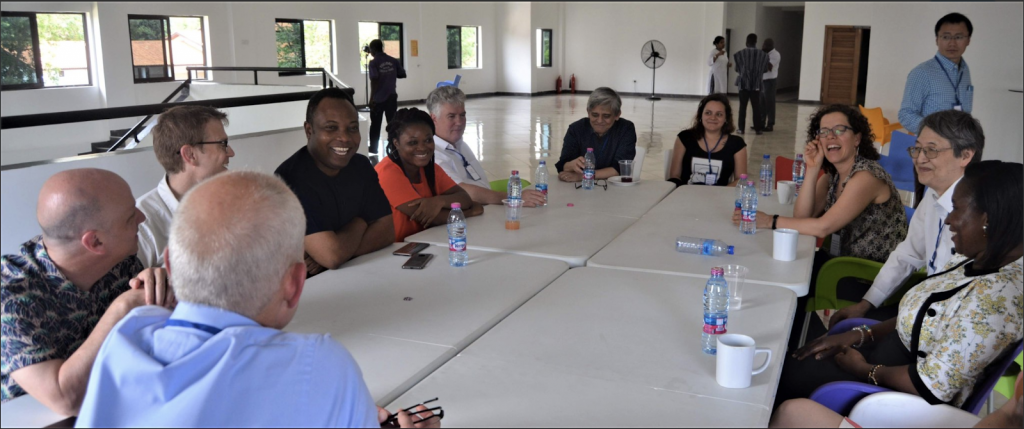Through my involvement with the Pathways to Equitable Healthy Cities project and internship through the Queen Elizabeth Scholars program, I was able to travel to both Accra and Nairobi this past summer to explore the topics of health equity and population health in two different urban health contexts.
Pathways Meeting and Thesis Work in Accra, Ghana
At the end of April, I travelled to Accra, Ghana where I attended the annual meeting for the Pathways project. As a group, we discussed various topics affecting urban health and sustainability including air quality and monitoring, the co-production of knowledge (discussed in a past blog post), water supply and sanitation, and several other topics of high importance to urban sustainability. Through various presentations and exercises, I was able to learn about shared barriers and facilitators to urban sustainability and health equity in the participating cities, providing inspiration for the remainder of my summer work.

For the next two months, I worked at the University of Ghana on my thesis research which involves studying the distribution of under-5 mortality, or the probability of a child dying before reaching the age of 5, in Accra. According to both UNICEF and The World Bank, under-5 mortality has been steadily declining in Ghana since 1960, which could be attributed to emerging health policies following the Millennium Development Goal 4 to drastically reduce under-5 mortality, such as the Making Pregnancy Safer Initiative. Although Ghana has experienced declining under-5 mortality over the past few decades, it remains imperative to map and report under-5 mortality at a fine spatial scale in Ghana to determine the relative inequality in under-5 mortality between areas of low and high socioeconomic status. Under-5 mortality has already been mapped across Ghana’s 110 districts based on the Ghana 2010 Census; however, my thesis work aims to map under-5 mortality a very fine spatial scale including 750 Ghanaian citizens, on average.
Under-5 mortality will be calculated using the 2010 Ghana Census, using information on children ever born and children surviving per woman interviewed in the census. In addition, I will be mapping household consumption expenditure across Accra, which is defined as the amount of money a household spends on goods and services to meet their everyday needs; encompassing the costs of housing, food, health services, and transportation.
Using household consumption as a proxy for socioeconomic status, I will then evaluate differences in under-5 mortality both between and within neighbourhoods with varying levels of socioeconomic status. Although previous research papers (including a mortality report by Ghana Statistical Services) have reported differences in under-5 mortality outcomes between Ghana’s urban and rural regions, this study will distinguish urban areas of Accra as slum or non-slum regions in order to compare under 5-mortality among urban slum, urban non-slum, and rural regions of Accra.
It is imperative to map out under-5 mortality in Accra at a fine spatial scale, as we will be able to identify areas which could be targeted for future public health interventions to reduce under-5 mortality, including whether these efforts should be targeted specifically toward urban slum or rural regions. Additionally, by investigating the inequality of under-5 mortality within geographical areas by brackets of socioeconomic status, we will be able to explore the importance of both geographical location and socioeconomic status in determining under-5 mortality.
Internship at the African Population and Health Research Centre (APHRC) in Nairobi, Kenya
In July, I travelled to Nairobi, Kenya to work as an intern at the APHRC, which is a research-driven public health organization striving to impact health policy in Africa. Here, I was able to conduct field work on a qualitative study assessing health facilities in slum areas of Nairobi, as well as write a literature review on contraception use for a study assessing HIV prevalence among young women living in Nairobi’s slum neighbourhoods.

Although contraception use in Nairobi has generally been increasing over the past few decades, the prevalence of contraception use among young and adolescent women remains low, with only approximately a quarter of young sexually-active women using contraception. Barriers restricting a young woman’s access to contraception include: the fear of adverse side effects; being perceived as promiscuous; family disapproval; financial burdens; and barriers imposed by health facilities such as service providers refusing to distribute contraceptives based on age or the requirement of already having at least one child. However, there are many facilitators promoting the use of contraceptives in Nairobi, including patient follow-up, patient knowledge of available contraceptives, approval from social networks including sexual partners, and already having at least one unplanned pregnancy.
By researching relative differences in under-5 mortality based on socioeconomic status as well as contraceptive use in young women living in Nairobi’s slums, I better understand the importance of studying health equity to potentially influence health policy in large urban cities. A focal objective of the Pathways to Equitable Healthy Cities project is to enhance healthy equity in cities across the world, and through my summer experience, I am inspired to continue research in urban health to ensure more people have equitable access to high-quality health services.
Further Reading:
Arku RE, Bennett JE, Castro MC, Agyeman-Duah K, Mintah SE, Ware JH, et al. Geographical Inequalities and Social and Environmental Risk Factors for Under-Five Mortality in Ghana in 2000 and 2010: Bayesian Spatial Analysis of Census Data. PLoS Med. 2016.
